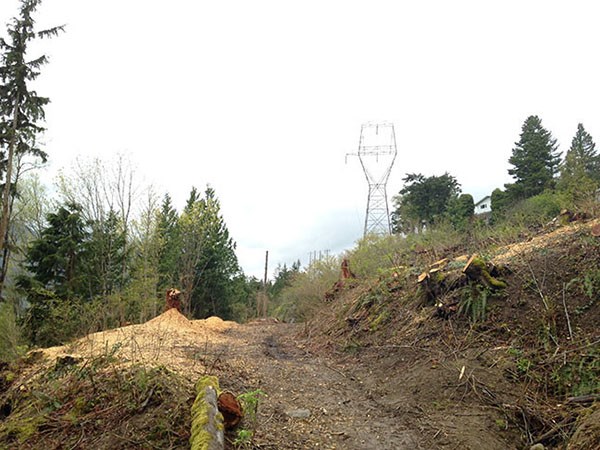Wendy Beaudoin and her neighbours in the Smoke Bluffs/Hospital Hill area say they fully understand the need for B.C. Hydro crews to conduct “vegetation management” around power lines from time to time.
But they’re raising questions about both the scope and timing of the work that has been ongoing in their neighbourhood since early April. Beaudoin, in fact, last week referred to the uprooting and destruction of birds because of ongoing tree clearing as a “genocide.”
A B.C. Hydro official on Friday (April 25) disputed that claim, saying the Crown corporation always takes steps to avoid unnecessary destruction of birds and their nesting sites.
Beaudoin, who lives on View Place, is one of a number of area residents who contacted The Chief to say they feel work ongoing near the base of Hospital Hill and the Smoke Bluffs was far more extensive than necessary, affecting not just birds but also nearby trails and even eliminating a sound barrier for noise on Highway 99.
Beaudoin and neighbours Brian Vincent and Carol Watts questioned the wisdom of conducting full-scale logging during prime bird nesting season.
Each day when the work starts up, the birds make quite a ruckus as they’re uprooted, said Beaudoin, adding that she hasfound at least six dead birds among the debris.
“I saw some wood ducks fall out of a tree the other day,” Beaudoin said. “They had been cutting around it and the ducks came flying out — they’d abandoned their nests, I guess.
“I’m just stressed right out with it. When you hear them all screaming and squawking and carrying on, it’s just heartbreaking.”
“I was just utterly mortified last night when I went down there at just by how invasive it has been,” Watts said. “It’s a wildlife corridor that’s filled with birds and it’s also a buffer zone from a sound point of view.
“My big concern is, ‘Do they have to cut so much, and during nesting season?”
Vincent, whose house is near the intersection of Clarke and Berhner drives, said he spoke to a B.C. Hydro project manager last week and was told officials conducted bird nesting surveys in the area before beginning the work.
Vincent said he thinks citizens should be allowed to see such reports to help ensure that B.C. Hydro is accountable for its actions.
“Are bird nesting reports made available to the public?” he asked in an email to The Chief. “Are the nesting reports open to independent peer review and comment? Were any birds, including raptors or birds identified as a sensitive species, identified in the area?”
B.C. Hydro spokesperson Mora Scott wrote in an email to The Chiefthat periodic pruning and tree removal are necessary to protect public safety and “ensure reliable electrical service for our customers.”
The B.C. Wildlife Act prohibits the disruption of birds or their active nests or eggs. By law, the nests of raptors such as eagles, herons, peregrine falcons, gyrfalcons or burrowing owls may not be disturbed at any time.
Bird nesting season varies from year to year, but generally runs from April 1 to July 31, District of Squamish officials said. Normally, B.C. Hydro crews carry out vegetation management work “just before the seasonal growth begins, Scott said.
“Our contractors are… trained in bird awareness and they complete pre-work surveys each day before any tree work is started,” she said. “They also continuously check trees and cavities for active nesting throughout the day. If protected or active nests are encountered, the contractors are instructed to immediately stop work and get assistance from a B.C. Hydro biologist or a qualified environmental professional.
In this case, “We are working hard to ensure we get through this work prior to full flush of the deciduous trees so that we have more visibility to check for active bird nesting,” Scott said. “We are confident that we have taken the necessary steps to mitigate any negative impacts to the birds.”
Said Vincent, “If that is their claim, I think the public has a right to see proof of that claim. The public should be granted access to any studies B.C. Hydro conducted of the area. We shouldn’t be asked to simply take B.C. Hydro’s word.”
District of Squamish (DOS) officials appear to have had minimal involvement in the Smoke Bluffs/Hospital Hill pruning and tree removal project.
Scott, however, said B.C. Hydro originally planned to carry out the work this September but moved it up at the request of DOS officials “to accommodate the [nearby] water main project.”
Christina Moore, DOS communications manager, said work on the water main project should be underway in the next few weeks. Neighbours will be notified before that project begins, she said.
Vincent said he was upset area residents had no advance warning or consultation on the vegetation work that was about to take place. He said the work began on April 7. The first public notification appears to have gone out as part of the DOS’s weekly newsletter on April 11.
Rod MacLeod, DOS director of engineering, said in an emailed response to The Chief’s questions that the district “requires compliance in instances where we have control, such as issuance of a development permit, but we have no control over work undertaken by provincial agencies” such as B.C. Hydro.
He added, “When we are told ahead of time about work to be conducted by Hydro, we communicate out to the public as necessary through the district’s general communications channels. We have had several discussions with Hydro regarding our wish to receive early notice ahead of time, and that has been taking place in most cases.”



